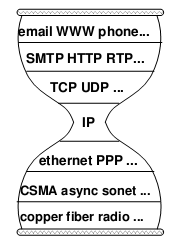SIGCOMM
2013-09-04
Is IP Enough?
Starting from middle school computer classes, we have been learning about the so-called “OSI seven-layer model” of computer networks, and I remember memorizing a lot of concepts back then. Those rotten textbooks have ruined many computer geniuses. In fact, this model is not difficult to understand: (those who have studied computer networks can skip this)
- Physical Layer: This is the medium for signal transmission, such as optical fiber, twisted pair (the network cable we commonly use), air (wifi)… Each medium requires its own encoding and modulation methods to convert data into electromagnetic waves for transmission.
- Data Link Layer: Let’s use an analogy. When speaking, you might accidentally say something wrong or hear something wrong, so you need a mechanism to correct errors and ask the other party to repeat (checksum, retransmission); when several people want to speak, you need a way to arbitrate who speaks first and who speaks later (channel allocation, carrier listening); a person needs to signal before and after speaking, so that others know he has finished speaking (framing).
- Network Layer: This was the most controversial place in the early days of computer networks. Traditional telecom giants believed that a portion of the bandwidth should be reserved on the path between the two endpoints, establishing a “virtual circuit” for communication between the two parties. However, during the Cold War, the U.S. Department of Defense required that the network being established should not be interrupted even if several lines in the middle were destroyed. Therefore, the “packet switching” scheme was finally adopted, dividing the data into several small pieces for separate packaging and delivery. Just like mailing a letter, if you want to deliver it to a distant machine, you need to write the address on the envelope, and the address should allow the postman to know which way to go to deliver it to the next level post office (for example, using the ID number as the address is a bad idea). The IP protocol is the de facto standard for network layer protocols, and everyone should know the IP address.
- Transport Layer: The most important application of computer networks in the early days was to establish a “connection” between two computers: remote login, remote printing, remote file access… The transport layer abstracts the concept of connection based on network layer data packets. The main difference between this “connection” and “virtual circuit” is that the “virtual circuit” reserves a certain bandwidth, while the “connection” is best-effort delivery, without any guarantee of bandwidth. Since most of the traffic on the Internet is bursty, packet switching improves resource utilization compared to virtual circuits. In fact, history often repeats itself. Nowadays, in data centers, due to predictable and controllable traffic, we are returning to the centrally controlled bandwidth reservation scheme.
- Application Layer: There is no need to say more about this, HTTP, FTP, BitTorrent that the Web is based on are all application layer protocols.
